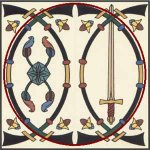Jewel-ry
In recent weeks, I have been carefully looking at the pip cards in my Marseilles decks, with a view to gaining a better understanding of their meaning.
Today, with the help of Gareth Knight and 'The magical world of the Tarot' (p95), I have laid out the tetractys with the Batons as so:
xxxxAxxxx
xxx3x2xxx
xx5x6x4xx
x9x7x8x10
In Knights scenario, which takes place on an imaginative stage, the Queen stands to the left and the King stands to the right.
I don't know if anyone else has ever done this but I have found, the laying out of these cards and reflecting on their meaning in the light of the surrounding cards somewhat enlightening.
I particularly like the central positioning of the Six, which, from my own personal reflections, I have to come to believe holds quite a special place in the tarot.
Another interesting observation is that the positions of all of the odd numbers is on the left hand side and the even numbers on the right hand side. Now, some of you may remember a thread I started a few days ago about the 'missing flowers', this becomes more evident when the cards are laid out like this. We have leaves on the left, but no flowers!
In the light of the left side representing feminine, passive, receptive, unconscious, and the right side being masculine, action, consciousness, I can now make more sense of the fact that some cards have no flowers. If the left side represents the feminine, there is probably more inner work going on, more reflection and introspection. There is no movement/action! It is in the even numbers.
So my question is - Is there a gender placed on number? If so, does it make sense to have it in this order? After all if the Le Bateleur represents the one, the self, the ego, should the number two be a female number?
Actually, I really hope some of you follow what I am trying to say here. I am finding it hard to explain myself. Any thoughts any-one???
Please???

Today, with the help of Gareth Knight and 'The magical world of the Tarot' (p95), I have laid out the tetractys with the Batons as so:
xxxxAxxxx
xxx3x2xxx
xx5x6x4xx
x9x7x8x10
In Knights scenario, which takes place on an imaginative stage, the Queen stands to the left and the King stands to the right.
I don't know if anyone else has ever done this but I have found, the laying out of these cards and reflecting on their meaning in the light of the surrounding cards somewhat enlightening.
I particularly like the central positioning of the Six, which, from my own personal reflections, I have to come to believe holds quite a special place in the tarot.
Another interesting observation is that the positions of all of the odd numbers is on the left hand side and the even numbers on the right hand side. Now, some of you may remember a thread I started a few days ago about the 'missing flowers', this becomes more evident when the cards are laid out like this. We have leaves on the left, but no flowers!
In the light of the left side representing feminine, passive, receptive, unconscious, and the right side being masculine, action, consciousness, I can now make more sense of the fact that some cards have no flowers. If the left side represents the feminine, there is probably more inner work going on, more reflection and introspection. There is no movement/action! It is in the even numbers.
So my question is - Is there a gender placed on number? If so, does it make sense to have it in this order? After all if the Le Bateleur represents the one, the self, the ego, should the number two be a female number?
Actually, I really hope some of you follow what I am trying to say here. I am finding it hard to explain myself. Any thoughts any-one???
Please???



